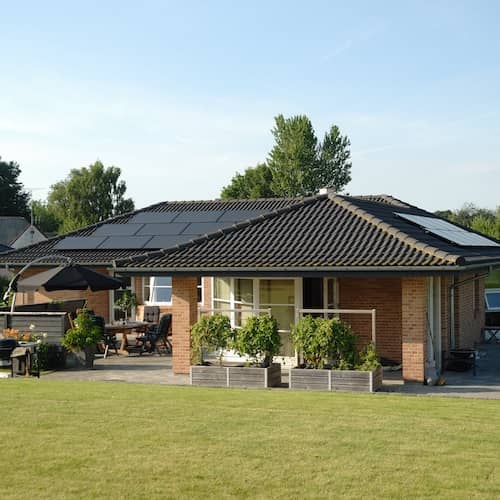Energy-efficient home: What it is and how to create one
Contributed by Karen Idelson
Oct 30, 2025
•6-minute read

You love your home and its amenities, but you might feel a tinge of guilt that it gobbles up a significant amount of energy and resources – and isn't as green as you'd like.
If you're an environmentally minded homeowner who is conscious about reducing your carbon footprint, investing in home upgrades might be top of mind. These can help reduce your utility consumption and energy-related costs.
Energy-efficient homes can mean a combination of energy-efficient appliances and lighting, combined with renewable energy systems. This can include anything from solar panels, smart home devices, green architecture, to tankless water heaters.
We'll explore different eco-friendly options to make your home more energy efficient, no matter your budget. That way, you can feel confident about your choices while also saving money.
What is an energy-efficient home?
In a nutshell, an energy-efficient home is one that uses less energy for a relatively equal amount of functionality and comfort. This can include heating and cooling equipment and appliances with high efficiency. It can also mean innovative, state-of-the-art lighting and electrical systems.
While your home might've come with appliances, they might be outdated, or aren't the most energy-efficient. And if you plan to do a major remodel, you can optimize the energy by way of a whole-home systems approach – think insulation and air sealing, space heating and cooling, and windows, doors, and skylights.
Here are some common systems and devices that tend to contribute the most to energy usage:
- HVAC systems: Short for heating, ventilation, and air-conditioning, HVAC's role is to keep your indoor air quality high.
- Hot water heaters: A hot water heater can use electricity, gas, or solar thermal energy to heat potable water for the home – think bathing or washing dishes.
- Kitchen appliances, washers, and dryers: The appliances to wash and dry your clothes and make your day-to-day life easier can consume a significant amount of energy.
- Lighting systems: Your home's lighting system is designed to provide and manage light. This includes lamps, recessed lighting, and your electrical sources of power.
- Overall electrical systems: These are all the components that receive and transmit electrical power and typically includes the breaker box, wiring, and outlets.
So how can you have an energy-efficient home? You can achieve this in a number of ways: using optimized appliances, going solar, and taking advantage of technology devices. You can also find ways to better maintain your property's temperature.
How to make your house more energy-efficient
While it might seem like an overwhelming endeavor, working through the process, step-by-step, can help you get to an eco-friendly home that's within your budget:
1. Do a home energy audit
Consider a DIY or professional home energy audit. That way, you can pinpoint what parts of your home are top of the list for energy-efficient improvements. An energy audit can involve reviewing past utility bills, checking the exterior for cracks and gaps, and inspecting appliances, insulation, and other aspects of the interior.
Something to keep in mind: some electric companies offer this service entirely for free. Depending on the company and the specifics of the program, a free energy audit also can mean income-qualified efficiency programs and rebates.
2. Consider installing solar panels
Solar panels convert sunlight into electrical energy in one of two ways – either through photovoltaic (PV) panels or through mirrors that essentially concentrate solar radiation.
In 2025, the average cost of solar panels is $30,000, but this depends on factors like the type of solar panels and size. While this is a hefty price tag, incentives can help bring down the cost.
Additionally, a solar loan can help fund this upgrade. While they're similar to home improvement loans, these loans are designed just for the purchase and installation of solar panels.
4. Purchase Energy Star-certified appliances
Another way to optimize your home for efficiency is for it to be Energy Star-certified. When a home system or appliance earns the ENERGY STAR label, it meets energy-efficiency specifications outlined by the U.S. Environmental Protection Agency (EPA).
Here are some household appliances with this certification:
- HVAC systems
- Dehumidifiers
- Water heaters
- Kitchen appliances
- Washers and dryers
- Pool pumps
- Ceiling fans
- Computers, monitors, and TVs
- Smart thermostats
- Air cleaners
Household appliances that are STAR-certified might be eligible for special offers, rebates, tax credits and tax deductions.
5. Install LED lighting
Whereas incandescent lighting emits light and heat in an omnidirectional fashion, LED lighting emits light in a specific direction.
In turn, LED lighting can use energy more efficiently. LED lighting can be found in the form of bulbs, recessed fixtures, and track lighting. Plus, they can cut energy use up to 90% and last up to 25 times longer than traditional incandescent bulbs.
The beauty of LED lighting is this can make for one of the less-pricey green upgrade options. It can be as simple as swapping out lightbulbs in a few rooms, which can help save on energy costs.
6. Use spray foam insulation
Quality, proper insulation in your home means resistance to heat flow, which can reduce your heating and cooling bills. In some ways, spray foam insulation is better than fiberglass insulation. For example, it can yield a higher R-value for the same amount of thickness and can fit the smallest of cavities. Plus, it can save you up to 50% on electric bills.
While spray foam insulation can be more difficult and expensive for older homes versus a new build, it might still be worth it alongside other major renovations.
7. Update your windows and doors
To help reduce heat gain and loss, consider updating your windows and doors. In turn, it can contribute to energy use savings for heating and cooling.
Window options such as caulking and weatherstripping, storm windows, solar control films, exterior shading, or complete replacement. For better insulation, consider upgrading doors or adding storm doors.
8. Purchase smart home devices
Many Wi-Fi-connected smart home devices help you bump down your energy usage through monitoring, programming and other controls.
Some common options include:
- Smart thermostats
- Smart lighting
- Smart plugs/powerstrips
- Smart shades
- Smart appliances
Besides saving on energy – which can also help you save on costs – a smart home equipped with smart home devices can also mean greater convenience, peace of mind, and safety. It can also boost your home value.
9. Conserve water
True story: The amount of energy it takes to treat and deliver water to your home 10 times a year is equal to the amount of power to keep a refrigerator up and running for 5 years.
Conserving water not only saves money on water bills, but can also reduce energy consumption by using less hot water.
To cut back on water usage, you can do some relatively easy changes, such as using water-saving showerheads and faucet aerators or by using a shower timer or a toilet tank bag. Other ideas include buying water-efficient appliances and installing a rainfall shutoff.
10. Opt for energy-efficient landscaping
You might've long dreamed of a lush green lawn. However, it can require substantial water, electricity, and chemical use.
You might want to consider sustainable landscaping approaches and green architecture and lawn care options. This can include collecting water in rain barrels for later use in the garden and using native plants that rely on rainwater. You can also plant trees that provide ample shade and make for a cooler home.
Do some homework and make choices that work best for your lifestyle, preferences, and climates.
For example, if you live in a temperate region of the country, you'll want to maximize shade in the summer and the warming effects of the sun in the winter. If you live in a hot-arid region, consider drought or native landscaping and plenty of shade to cool roofs and windows.
Are energy-efficient homes worth it?
Energy-efficient improvements to your home can mean a smaller environmental footprint, lowering your energy bills over time, potentially improved comfort, and a higher resale value.
While these upgrades can mean an investment of time, effort, and money, energy-efficient mortgages, home improvement grants, and other resources such as Fannie Mae's Green MBS (mortgage-backed securities) program can help make these expenses more manageable.
The bottom line: An energy-efficient home can save you money over time
While making upgrades to your home to boost its energy efficiency can make for more sustainable and efficient living that can put money back into your pocket, you'll want to compare the costs against savings.
While it does require an upfront investment, you'll be able to enjoy the long-term benefits of an efficient home that's in sync with your values.
Currently, Rocket Mortgage® doesn't have energy-efficient mortgages. However, other types of loans are available.

Jackie Lam
Jackie Lam is a seasoned freelance writer who writes about personal finance, money and relationships, renewable energy and small business. She is also an AFC® financial coach and educator who helps creative freelancers and artists overcome mental blocks and develop a healthy relationship with their finances. You can find Jackie in water aerobics class, biking, drumming and organizing her massive sticker collection.
Related resources
6-minute read
Green architecture: What is it, and what are its goals?
Green architecture is a design movement committed to building homes that don’t damage our environment. Learn more about the principles of green archite...
Read more
3-minute read
An overview on the green MBS program
Fannie Mae offers green MBS (mortgage-backed securities) to provide borrowers with a green financing option. You can learn more about this initiative here.
Read more
10-minute read
Home improvement grants to fund your next repair project
Home improvement grants are a type of financial aid for homeowners to make necessary repairs to their home. Check out our guide to find grant resources.
Read more